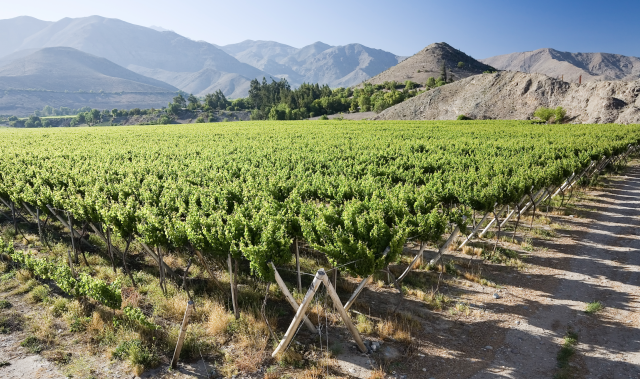Chile abandoning vineyards as sales decline
By Patrick SchmittSuch is the global decline in wine consumption, a country like Chile is abandoning vineyards, and in some cases considering removing them altogether, according to Sebastian Labbé, the winemaker for Viña Santa Rita’s finest labels, including Casa Real.

The move can be compared to what’s happening in Bordeaux, where it was agreed in March this year that the region would remove almost 10,000 hectares of vineyards due to oversupply, but unlike in France – where €57 million has been put aside for growers to cease wine production – Chilean vintners will receive no financial support for pulling up vines.
Labbé painted a fairly bleak picture of the present situation in Chile during a meeting with db in London earlier this month, although he also drew attention to positive aspects to wine production in the Latin American country – above all the quality of the latest harvest, which he described as a “fantastic vintage”.
But it is a decline in both domestic and foreign demand for Chilean wine – particularly at the lower end – that concerns Labbé most immediately.
Speaking about mounting stocks of wine in the country, he said that producers were starting to worry, as they would need to sell what’s in vat and barrel soon to make room for the next vintage – which will start to be picked in five months’ time.
“There’s a new vintage coming, and producers need the space,” he said.
Continuing, he said that Viña Santa Rita was in a relatively strong position, having seen sales in the past 12 months hover at “around 8-9% below budget”, but other “big names are 30-40% down”, he recorded.
As a result of a decline in sales, which he attributed to falling demand in key export markets, particularly China, combined with low levels of domestic wine consumption – which he said is just 12 litres per capita per year – he told db that “a lot of vineyards have not even been picked this year.”
Looking further ahead, he believes that such sites may be removed from production entirely.
“We have 130,000 hectares in Chile, and a great number of those will be pulled out,” he said.
“Many of them have not been farmed this year, and they only haven’t been pulled out because that requires an investment,” he added.
Continuing he said, “We are looking at a couple of very difficult years in Chile, with probably this vintage the next one being tricky.”
However, on a more positive note, he said that the falling demand was for entry-level wines, noting that the “higher tier” – which he defined as wines above $500 a case – “are growing” in sales.
Furthermore, he said that this year’s harvest was “a fantastic vintage”, noting that it was not hot like 2020 – “which was the warmest of the past three decades” – but “mild”, recording that the latest harvest reached a total of 1703 growing degree days (GDD), referring to the sum in the Maipo Valley.
This, he told db, “is slightly above the average over the past 20 years, which is 1663, and above 2018, which was cool, with 1642 GDD.”
Partner Content
But, while 2023 has hit the headlines for hot and dry conditions, he said that “the high temperatures during the day came down quickly at night, which was unlike in 2020, when the temperatures rose and then stayed up there for longer periods.”
Consequently, he said that 2023 saw huge diurnal temperature differences of up to 19 degrees Celsius, which has ensured that the resulting wines “have kept their freshness”.
Indeed, he described the wines from 2023 as ripe, without any herbal character. Furthermore, due to picking early – “probably our earliest ever” – Santa Rita has alcohols of 13.2-13.3%, according to Labbé, when speaking about the Cabernets destined for his flagship wine, Casa Real.
Labbé’s observations about the global demand for entry-level wine echoed those aired by Vinexposium CEO, Rodolphe Lameyse at a press conference in London last week.
Drawing on IWSR data, Lameyse said that the biggest declines in 2022 and projected for the end of this year are in the ‘value and below’ wine sector, which covers the cheapest end of the market, with the fall-off in sales much greater than in beer or spirits – although these categories are also suffering from decreasing sales at this low-price-level sector.
In contrast, for wine – along with beer and spirits – there is growth in ‘superpremium and above’, which Lameyse said covers bottles of wine priced in retail at €20 or more, while he expressed hope for a comeback in sales of wine in the US, and more immediately, China too.
“The main question concerns the level of stocks, which are high in the US, and very high in China, and consumption is not picking up,” he began, before adding, “It is a very fragile situation, and the next coming months will be crucial.”
According to figures released by the World Bulk Wine Exhibition (WBWE), in the first half of 2023, Chile’s bulk wine exports fell by more than 25%, accounting for 11.32m hl, representing a total of US$124.7m.
Bulk wine accounted for 41% of the volume and 17% of the total value of Chile’s wine exports in the first six months of this year, according to the WBWE.
Meanwhile, bottled wine exports suffered similar levels of decline, with a drop of almost 25% in both volume and value. Bottle wine exports from Chile account for a little over 56% of the volume and 80% of the value.
Read more
Global wine trade in ‘fragile situation’ says Vinexposium CEO
Drought and disease see wine production fall to 60-year low
Bordeaux agrees fund to pull up thousands of hectares of vineyards
Related news
Freixenet celebrates Mother's Day with multi-channel activations
Why the wine rarely vanishes – the truth about cooking with alcohol




